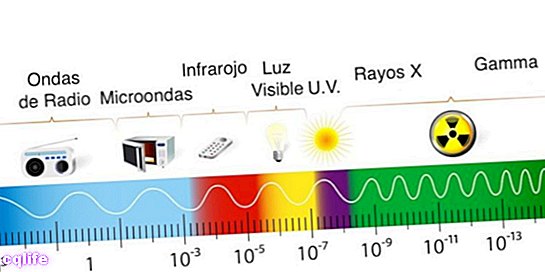- What is the electromagnetic spectrum?
- Regions of the electromagnetic spectrum
- Uses of the electromagnetic spectrum
- Importance of the electromagnetic spectrum
We explain what the electromagnetic spectrum is, in which regions it is divided, what it is used for and how it was discovered.

What is the electromagnetic spectrum?
The electromagnetic spectrum is the distribution of energies of electromagnetic radiation. It can be expressed in terms of energy, although it is more commonly done in terms of the wavelength and frequencies of radiation. It ranges from radiation with a shorter wavelength (gamma rays) to those with a longer wavelength (radio waves).
It is made up of various subranges or portions, the boundaries of which are not entirely defined and tend to overlap. Each band of the spectrum is distinguished from the others in the behavior of its waves during emission, transmission and absorption, as well as in its practical applications.
Electromagnetic waves are vibrations of the electric fields Y magnetic that carry energy. Arewaves propagate in a vacuum at speed of the light.
When talking about the electromagnetic spectrum of an object, we refer to the different wavelengths that it emits (called the emission spectrum) or absorbs (called the absorption spectrum), thus generating an energy distribution in the form of a set of electromagnetic waves.
The characteristics of this distribution depend on thefrequency or the wavelength of the oscillations, as well as their energy. The three quantities are associated with each other: a given wavelength corresponds to a frequency and a certain energy. Electromagnetic waves can associate with a particle called a photon.
The electromagnetic spectrum was discovered as a result ofexperiments and the contributions of the British James Maxwell, who discovered the presence of electromagnetic waves and formalized the equations of his study (known as Maxwell's equations).
Regions of the electromagnetic spectrum
The electromagnetic spectrum, in principle, is practically infinite (for example, the longest wavelength would be the size of the universe) and continuous, but so far we have been able to know some of its regions, known as bands or segments. These are, from smallest to largest:
- Gamma rays. With a wavelength less than 10-11 meters (m) and a frequency greater than 1019.
- X-rays. With a wavelength less than 10-8 m and a frequency greater than 1016.
- Extreme ultraviolet radiation. With a wavelength less than 10-8 m and a frequency greater than 1.5 × 1015.
- Near ultraviolet radiation. With a wavelength less than 380 × 10-9 m and a frequency greater than 7.89 × 1014.
- Visible spectrum of light. With a wavelength less than 780 × 10-9 m and a frequency greater than 384 × 1012.
- Near infrared. With a wavelength less than 2.5 × 10-6 m and a frequency greater than 120 × 1012.
- Mid infrared. With a wavelength less than 50 × 10-6 m and a frequency greater than 6 × 1012.
- Far infrared or submillimeter. With a wavelength less than 350 × 10-6 m and a frequency greater than 300 × 109.
- Microwave radiation. With a wavelength less than 10-2 m and a frequency greater than 3 × 108.
- Ultra high frequency radio waves. With a wavelength less than 1 m and a frequency greater than 300 × 106.
- Very high frequency radio waves. With a wavelength less than 100 m, a frequency greater than 30 × 106Hz.
- Short radio wave. With a wavelength less than 180 m and a frequency greater than 1.7 × 106.
- Medium radio wave. With a wavelength less than 650 m and a frequency greater than 650 × 103Hz.
- Long radio wave. With a wavelength less than 104 m and a frequency greater than 30 × 103.
- Very low frequency radio wave. With a wavelength greater than 104 m, a frequency less than 30 × 103 Hz.
The regions of the electromagnetic spectrum are gamma rays, x-rays, ultraviolet radiation, the visible spectrum, microwaves, and radio frequency.
Uses of the electromagnetic spectrum

The uses of the electromagnetic spectrum can be very diverse. For example:
- Radio frequency waves. They are used to transmit information over the air, such as radio broadcasts, TV or Internet Wifi.
- The microwaves. They are also used to transmit information, such as mobile phone signals (cellular) or microwave antennas. It is also used by satellites as a mechanism for transmitting information to the ground. And they serve, at the same time, to heat food in microwave ovens.
- Ultraviolet radiation. It is issued by the Sun and absorbed by the plants for the photosynthesis, as well as for our skin when we tan. It also feeds the fluorescent tubes and allows the existence of facilities such as solariums.
- Infrared radiation. It is the one that transmits the heat from the Sun to our planet, from a fire to the objects around it, or from a heater inside our rooms.
- The spectrum of visible light. It makes things visible. In addition, it can be used for other visual mechanisms such as movie theater, flashlights, etc.
- X-rays are used in medicine to take visual impressions of the interior of our bodies, as well as our bones, while the much more violent gamma rays are used as a form of radiation therapy or cancer treatment, since they destroy the DNA of the cells that reproduce out of order.
Importance of the electromagnetic spectrum
In the contemporary world, the electromagnetic spectrum is a key element for telecommunications and the transmission of information. It is also essential in exploratory techniques (radar / sonar type) of outer space as a way to understand distant astronomical phenomena in the weather and the space.
It has various medical and practical applications that are also part of what we take today as quality of life. That is why its manipulation is, without a doubt, one of the great discoveries of humanity.
